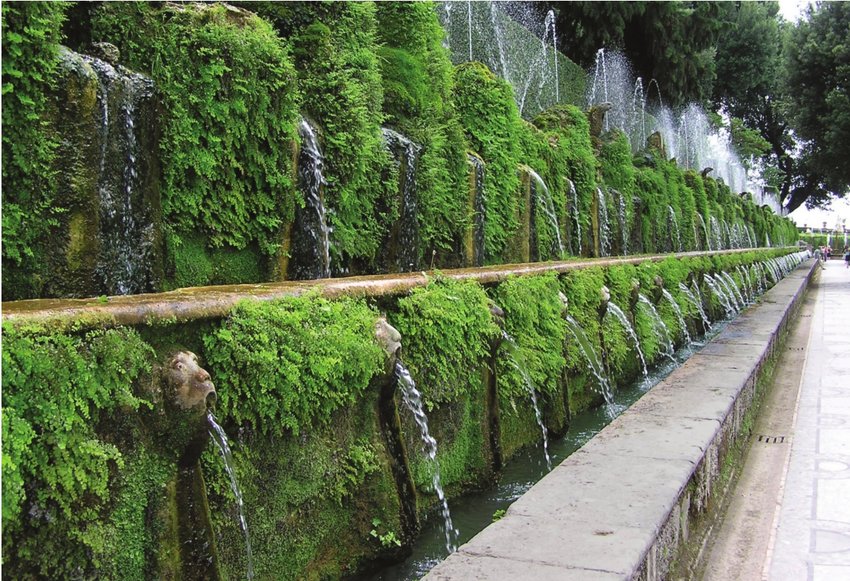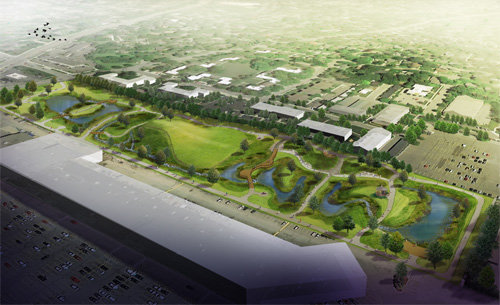
A slow whirlpool of pollution control, economic development and public art, the most ambitious and creative project for managing storm water in greater Lansing, is accelerating down the drain.
In a good way.
On Thursday, Ingham County Drain Commissioner Pat Lindemann will unveil the most detailed and specific plans yet for the Montgomery Drain project, which he expects to cost $22 million to $30 million. Over the weekend, Lindemann gave City Pulse a preview of what he will present at the Lansing Center as part of the Placemaking Summit organized by the Arts Council of Greater Lansing.
For decades, the Montgomery Drain’s service area has served as a vast urban toilet where rain flushes tons of runoff, from tire rubber to toxic metals to cigarette butts, straight into the Red Cedar River. The service area is centered on the parking lot of the Frandor shopping center, a flat basin that swirls with rain in summer and is piled with dirty mountains of snow in the winter. The area also includes strip malls and a subdivision to the north and the highways that pass through it, including I-127.
Some 50,000 to 75,000 pounds of pollutants slide from the drain’s service area into the Red Cedar each year, according to data from Lindemann and the Ingham County Health Department.
A watershed becomes “very impaired” when about 15 percent of it is paved over, according to Tom Scheueler, a 30-year veteran of watershed studies as director of the Chesapeake Watershed Network. Frandor and its environs form a carapace of concrete and asphalt that’s almost 80 percent impervious. A drop of rain with the bad fortune to fall almost anywhere on the Montgomery Drain service area will find itself in the river, dirty, in about 15 minutes, Lindemann said.
Walls of water
The proposed drain combines familiar, low-impact features, using natural processes to filter storm water, and new ideas that take advantage of the area’s unique landscape.
Ranney Park, to the north of Ranney Skate Park and ball field, will become a pocket park of water retention ponds and foot trails, much like the region’s other low-impact storm water treatment facility, the Tollgate Wetlands, in the Groesbeck neighborhood to the north. Ranney Park’s signature sledding hill will remain, but the slope will be reversed, so the southern exposure won’t melt the snow as fast.
Storm water will tumble down 23 waterfalls along the way to the river, taking advantage of the 10-foot slope of the land from the north end of Frandor to Michigan Avenue. The air contact and turbulence will oxygenate the water. Liners of limestone under the rushing water will “gasify” acids, pushing them into the air via bubbles.
“Wherever we can, we use gravity to move the water,” Lindemann said. “The bulk of it is going downhill. We’re employing natural cleaning systems to do the job for us.”
In the Frandor Shopping Center, engineers will take advantage of two large retaining walls, one each behind the Red Lobster restaurant and Marshall Music, to install “water quality walls” that will look like something Vitruvius, the Roman master of the aqueducts, would have designed.
Dirty water will tumble through the hollow walls, where it will circulate through a series of filters and be spat out, fountain-style, by sculpted heads — of real local people. The heads tie into another project, “Art in the Wild,” that will introduce artwork to the concrete jungle along with the green spots. (See related story.)
The filter-bearing walls of water look lavish, but because they are above ground, they will be easier to service and clean than underground storm water pollution filters and cost about 14 times less to build, Lindemann said.

The Frandor parking lot itself, and some of the surrounding commercial lots, will be retrofitted with rain gardens and swales as well.
Underground pipes will carry the water south, to the former Red Cedar golf course on Michigan Avenue, where the project will dovetail with the proposed $270 million Red Cedar Renaissance mixed-use development. More retention ponds and other natural features will border the floodway south of the development, leading to a full-on natural area at the edge of the river.
Lindemann also hopes to take advantage of the presence of heavy earthmovers near the site to use a $1 million state grant to rebuild the Red Cedar River and establish fish habitat. The work would include laying gravel beds where steelhead trout and salmon can lay eggs, shaping the riverbanks to minimize runoff onto the beds, and narrowing the banks so the river would run faster and wash the beds.
Lindemann said the proposed drain will cut pollution by 95 percent. Right now, contaminated storm water goes straight to the Red Cedar with no filtration at all.
Where will the pollution go?
“The point, as with any filter, is to concentrate unwanted gunk in one place where it can be dealt with,” Lindemann said.
Some pollutants, even metals, decompose and are absorbed by the plants in the ponds, rain gardens and walls. Copper, zinc and iron oxidize in the soil, become inert and even feed the plants. Other pollutants, such as mercury and chrome, are collected and hauled away. Some of the solids in the filtration walls will flush into the sanitary sewer system. Lindemann compared the filters in the walls and the engineered soil in the ponds to furnace filters that have to be changed at various intervals (every 20 years or so, in the case of the ponds).
Cost concerns
When Lindemann and his engineers arrive at a final cost estimate for the Montgomery Drain, which he expects to have by the end of the year, he’ll bid the project out and the county will issue bonds, or borrow the money, to pay for the work.
Five jurisdictions in the service area will share the cost of the project: Lansing, Lansing Township, East Lansing, Michigan’s Department of Transportation (because of the state highways running through the service area) and Ingham County (for county roads).
To pay off the bonds, the jurisdictions can tax property owners in the district or pay out of the general fund, or some combination.
Property owners will have a chance to appeal any levies that may be imposed. Lindemann expects some to do so, and he is girding for the possibility that others may sue him over the project. But he said it would cost far more, up to $120 million, to clean the water in conventional fashion, by upgrading existing storm water system with new pipes, filters and catch basins.
“A rain garden costs 5 percent of a 96-inch pipe,” he said. “Yes, you have to maintain it, but fine, we have to maintain it.”
Financing the drain project is not directly linked to the massive Red Cedar Renaissance project, but the prospect of two hotels, a medical building, retail, restaurants, town homes and student housing for over 1,000 people smack in the middle of the service area, sharing the tax burden, is a deal sweetener for more than one reason.
“The drain has to be fixed,” Lindemann said. The latest phase of the federal Clean Water Act requires municipalities to set plans for cleaning up non-point source pollution. “The bigger the development, the less everyone else has to pay. If the drain isn’t accompanied by that increase in economic development, the lion’s share will be bigger for everyone else.”
But Lindemann said the drain project will go ahead, whether or not the Red Cedar Renaissance does. Developers Joel Ferguson and Frank Kass have said they are moving ahead with the work, but they are fighting a lawsuit from a former partner alleging racketeering and are waiting for the county to decide whether it will issue bonds to finance the “plinth,” or concrete pad upon which the development must rest to keep it over the floodplain.
Despite the delays, Lindemann is still coordinating drain work with Ferguson and Kass.
“We don’t want to move the same shovelful of dirt twice,” Lindemann said.

At Thursday’s placemaking conference, Lindemann will pull back to take a long view of the project’s significance.
Tests by the Ingham County Health Department found that since 2000, total body contact has not been recommended about 70 percent of the time for the Red Cedar River.
To Lindemann, that’s unforgivable. The Clean Water Act called for fishable, swimmable water by 1985.
Lindemann will tell anyone with ears that only 2.5 percent of the world’s water is fresh water, of which only 0.5 percent is usable. The rest is tied up in glaciers (69.5 percent) and deep groundwater (30 percent). Out of that usable fresh water, 20 percent is in the Great Lakes Basin.
“This is where the world’s stash of clean water is, and this is where we have to protect it,” Lindemann said. “It’s too late to do it right the first time, so we have to retrofit.”
Support City Pulse - Donate Today!
Comments
No comments on this item Please log in to comment by clicking here